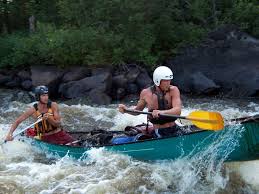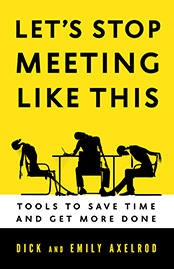Save time and get more done in a “Meeting Canoe”
 Meetings can be wildly successful and help your team reach new heights in performance or they can be an expensive waste of time. Unfortunately, many large and small organizations experience more of the latter. Authors Dick and Emily Axelrod have dedicated their careers to understanding and promoting what makes an impactful meeting in Let’s Stop Meeting Like This: Tools to Save Time and Get More Done gimp nederlands downloaden windows 10.
Meetings can be wildly successful and help your team reach new heights in performance or they can be an expensive waste of time. Unfortunately, many large and small organizations experience more of the latter. Authors Dick and Emily Axelrod have dedicated their careers to understanding and promoting what makes an impactful meeting in Let’s Stop Meeting Like This: Tools to Save Time and Get More Done gimp nederlands downloaden windows 10.
The Axelrods explain step by step how to participate in highly effective meetings no matter your role: a leader, contributor or facilitator. The Meeting Canoe™ is an approach that helps readers understand the importance of order, shape and flow to your gatherings german mau mau for free.
Are your meetings like a raft or canoe?
“The Meeting Canoe™ is a complete rethinking of the meeting design, execution and follow-up,” say the Axelrods. Compare the canoe with a raft, for example. When we think of rafts, we envision a lazy drift down the river that’s subject to the current while a canoe involves a team of oarsmen and the crew controls the direction eigene tik tok videos herunterladen. The Axelrods think there are too many meetings that feel like rafts when they could be canoes.
oarsmen and the crew controls the direction eigene tik tok videos herunterladen. The Axelrods think there are too many meetings that feel like rafts when they could be canoes.
According to the authors, the Meeting Canoe™ is a relevant and useful system because:
The Meeting Canoe™’s parts influence each other.
The Meeting Canoe™ interacts with its environment as the crew adapts to changing conditions.
No single part is effective without the other parts Spotify laptop.
How well the Meeting Canoe™ functions depends on how well the parts work together.
We’ve excerpted our interview with the Axelrods below to give you a sense of how their framework can transform your meetings and a look at bad meeting habits.
CausePlanet: Thank you for adding the Meeting Canoe™ framework to the body of literature about effective meetings ing appen op laptop. It’s a terrific addition. Which part of the Meeting Canoe™ do most users find most transformational when implementing the approach?
Dick and Emily: Welcome, Connect, and Attend to the End. Most meeting agendas call for a perfunctory welcome and do not spend time connecting people to each other and the task. The result is they fail to build a solid foundation to do the meeting’s work embedded videos chrome. Similarly, most meeting agendas ignore attending to the end. This results in people being unclear about what was decided during the meeting as well as next steps following the meeting. Failure to spend time discussing how to make future meetings better leaves the group without a self-correcting mechanism. We learned from an architect colleague that how people enter a space and how they leave a space is as important as what happens in the space how to download music for free. We believe this is true for meetings as well. By paying attention to the Welcome, Connect, and Attend to the End parts of the Meeting Canoe™, meeting designers create a complete, productive meeting experience.
CausePlanet: In your research or client experiences, did you discover why most people accept and perpetuate bad meeting habits einladung geburtstag kostenlos download whatsapp?
Dick and Emily: The first is that when we asked meeting participants whom they thought was responsible for a meeting’s success, the most frequent response was “the leader.” This habit is an abdication of responsibility for what happens during the meeting, which allows meeting participants to sit idly by while a meeting goes downhill. We believe another cause is that people have come to think about meetings as painful experiences that must be endured. They do not think of them as a place where productive work occurs wie kann man alle spiele herunterladen. This becomes a self-fulfilling prophecy. When you begin to think about meetings as a place where people do work, then you can design your meetings using the five proven work design principles:
Autonomy: the power to influence the meeting’s direction
Meaning: the meeting has importance or significance to participants
Challenge: a call to engage in something that tests your knowledge, skill, ability or courage
Learning: acquiring new skills or knowledge through experience, study or being taught
Feedback: information that lets meeting participants know whether a meeting is making progress toward its objectives.
When you apply these design criteria to your meeting, you create the conditions for productive work to occur.
A quotation in Let’s Stop Meeting Like This by author, speaker and consultant Peter Block aptly describes the challenges the Axelrods address with their model office kostenlos downloaden chip. Block says, “If you look at the way we meet in organizations and communities across the country, you see a lot of presenters, a lot of podiums, and a lot of passive audiences. This reflects our naiveté in how to bring people together.” If you find your meetings have fallen into an unproductive or passive pattern and you feel like you’re swimming upstream, get your team in the Meeting Canoe™.
See also:
World Cafe: Shaping Our World Through Conversations That Matter
Image credits: en.wikipedia.org, matt-gibson.org, flickr.com







